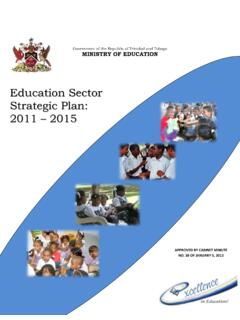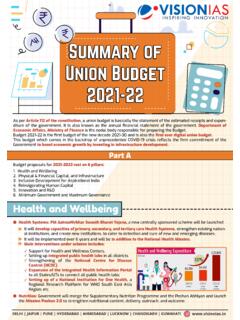Transcription of VISION 2030 JAMAICA NATIONAL DEVELOPMENT PLAN …
1 VISION 2030 JAMAICA NATIONAL DEVELOPMENT plan EDUCATION DRAFT SECTOR plan FINAL DRAFT Every child can learn .. Every child must learn Children entering school today will engage in careers that have not yet been invented, but will become obsolete within their lifetime JUNE 2009 1 Edited October 2009 EDUCATION EDUCATION EDUCATION EDUCATION SECTOR PLANSECTOR PLANSECTOR PLANSECTOR plan 2009 2009 2009 2009 ---- 2030 2030 2030 2030 Table of Contents Page # Section 1 - Introduction 3 Section 2 Situational Analysis 6 Background and Context 6 Major Achievements in Education 8 Key Issues and Challenges 9 Financing Education 10 Population and Demographics of the Education System 14 The Institutional and Legislative Framework 17 Analysis of the Education System by Level 18 Section 3 SWOT Analysis
2 39 Section 4 Strategic VISION and Planning Framework 44 Section 5 Implementation Framework and Action plan 47 Section 6 - Monitoring and Evaluation Framework 71 List of Acronyms 75 Appendices 77 3 SECTION 1- INTRODUCTION Education and training are emerging as key drivers of a country s competitiveness1. The world is characterised by rapid change, increasing globalisation and growing complexity in terms of economic and socio-cultural relations. The speed of these changes provides a context within which the future objectives of education and training systems must be placed. globally , many countries are transforming their education systems and establishing increasingly ambitious and challenging goals.
3 For example, Cuba has decided to aim for university level education for its entire population, while in Trinidad every child has access to free education at all levels, and the VISION for Barbados is to have one tertiary trained person in every household by 2020. In New Zealand education has moved from a mainly centralized structure to one in which individual schools and tertiary institutions are largely responsible for their own governance and management, working within the framework of guidelines, requirements and funding arrangements set by central government and administered through its agencies.
4 The educational level of a country is a determinant of the stage of its economic DEVELOPMENT and potential for future growth. Investment in education is important, enabling the DEVELOPMENT of each person s full potential and consequently creating a competitive workforce. Education is therefore a social indicator of a country s economic DEVELOPMENT and the stock and quality of its human capital. On an individual level, formal education is one of several important contributors to the skills and socialisation of an individual and helps citizens to learn how to function in society and be successful in life.
5 The Sector plan for Education is influenced by the guiding principles in the VISION 2030 JAMAICA - NATIONAL DEVELOPMENT plan and is based on a shared VISION of placing JAMAICA prominently on the global map in terms of excellence in education. The plan will build on work already undertaken by the Task Force on Education Transformation. It recognizes the importance of the integration between education and training. However, the analysis 1 World Economic Forum, Global Competitiveness Report 2006 4 in this plan focuses on the formal and non-formal educational programmes from pre-primary to tertiary.
6 Another plan , focusing on Training and Workforce DEVELOPMENT , targets the training institutions and programmes including training activities of secondary schools, post-secondary and tertiary institutions in preparation for the labour market. This Sector plan is one of thirty one that form the foundation for the DEVELOPMENT of VISION 2030 JAMAICA NATIONAL DEVELOPMENT plan - a long term plan designed to put JAMAICA in a position to achieve developed country status by 2030. VISION 2030 JAMAICA is based on a fundamental VISION to make JAMAICA the place of choice to, live, work, raise families and do business , and on guiding principles which put people at the centre of JAMAICA s transformation.
7 Twelve strategic priorities have been identified as critical elements in fulfilling the objectives of the plan . The VISION statement for this Sector plan is: Well resourced, internationally recognised, values based system that develops critical thinking, life-long learners who are productive and successful and effectively contribute to an improved quality of life at the personal, NATIONAL and global levels . This VISION focuses on facilitating equality of opportunities, social cohesion and partnerships. The plan envisages that the average beneficiary of our education and training system will have completed the secondary level of education, acquired a vocational skill, be proficient in the English Language, a foreign language, Mathematics, a science subject, Information Technology, participated in sports and the arts, be aware and proud of our local culture and possess excellent interpersonal skills and workplace attitudes.
8 The preparation of the Education Sector plan has been supported by a quantitative systems dynamics model Threshold 21 JAMAICA (T21 JAMAICA ) which supports comprehensive, integrated planning that enables the integration of a broad range of interconnected factors inclusive of economic, social and environmental considerations. The T21 JAMAICA is able to project future consequences of different strategies across a range of indicators. In addition, it will enable planners to trace causes of changes in any variable or indicator back to the assumptions. 5 The first draft of this Sector plan was developed using the following processes: 1.
9 Task Force Meetings to solicit ideas and views from members2 on issues and challenges facing the educational sector in JAMAICA as well as identifying a VISION for Education in JAMAICA , and determining key goals, objectives and strategies for the sector; 2. building on the work undertaken by the Education Transformation Task Force and adopting the goals and objectives contained therein - the initiatives of the transformation programme are centred on improving quality, equity and access. The activities include the modernization of the Ministry of Education (MOE), the decentralising of the administration of the school system, improvement in teacher quality, provision of additional school spaces, reduction in teacher-pupil ratio, improvement in quality assurance and increased stakeholder participation.
10 These activities are scheduled to be accomplished by 2016; 3. research on international best practices and experiences from other developed and developing countries including Australia, New Zealand, Japan, Cuba, the United Kingdom and the United States of America in education that could be adopted in the Jamaican context; 4. a strategic meeting between the Chair of the Task Force, Chairman of the PAG, the consultant and the Technical Secretary of the PIOJ; 5. a strategic meeting with the Chair of the Education Task Force and the Chair of the Training & Workforce DEVELOPMENT Task Force towards identifying cross-cutting issues and synchronization of the planning process; and 6.






